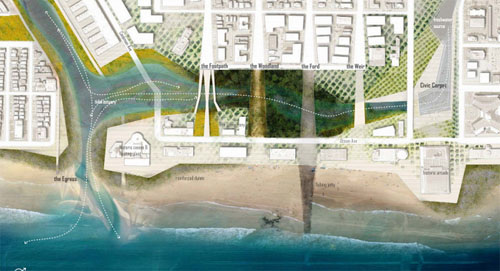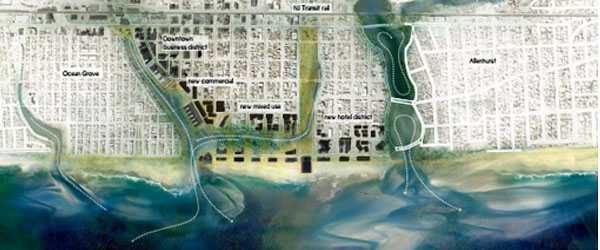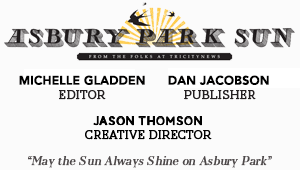Shade Tree Commission discusses long-term resiliency
Presentation re-imagines coastal lakes as estuaries
The Asbury Park Environment and Shade Tree Commission [ESTC] heard a presentation Monday on coastal resiliency given by Claire Hoch, an architecture and landscaping student from The University of Pennsylvania.
The presentation stems from the city’s attempt to win state grant funds from the department of Housing and Urban Development’s “Rebuild by Design” competition. Two of the ten competition teams selected Asbury Park as the location they would like to see their unique design ideas for future storm resiliency realized. Both teams lost their bid to win the competition.
Although the competition funds were allocated to other projects throughout the Sandy-affected region, Asbury Park left an impression on the Rebuild By Design team and discussions on future storm resiliency have continued among team members and city officials.
A member of one of the winning design teams, Ellen Neises, a professor at UPENN, charged students in her landscape architecture studio course with developing projects that tackle coastal resilience.
With its strong city history, cultural diversity and inland appeal, Neises’ student, Hoch, chose Asbury Park for her project’s focus.
“In talking about resiliency, one thinks coastal protection and we tend to forget a more urban or cultural element inherent in it,” Hoch said.
Hoch’s project, which Neises said caught the eye of faculty and professionals in the ecology and hydrology fields, envisions the city’s three coastal lakes as estuaries using the majority of vacant land along Kingsley Street as a way to funnel water from Sunset and Wesley lakes out into the Ocean and re-opening Deal Lake to the Atlantic [rendering shown at top].
Current storm mitigation plans put beach nourishment as the primary means of storm recovery along the state’s coast, but the process masks the dynamism of the coast and merely erases the sense of risk taken by homeowners, Hoch said.
“I thin that this replenishment is an undertaking that created a sameness from town to town along the coast,” she said. “It’s something that doesn’t really allow [people] to experience towns in and of themselves.”
The topography of the New Jersey “headlands” region, where Asbury Park sits, is higher than the Barrier Island, and the majority of the city’s flood problems have to do with slow drainage from the coastal lakes rather than wave action, she said, which puts the city in a “good position to try something new and different” since there is less of an immediate threat.
 Her plan sees a nature park for recreational lake activities and an open tidal estuary with a barrier that can be put in place to hold back inland tidal flow if necessary where Deal Lake meets the ocean, and a spillway from Sunset Lake surrounded by lush trees and other biodiverse elements that stretches from Fifth Avenue south, connects to Wesley Lake, and leads out to an egress along the Ocean Grove border on the south side of the old steam plant [shown at left].
Her plan sees a nature park for recreational lake activities and an open tidal estuary with a barrier that can be put in place to hold back inland tidal flow if necessary where Deal Lake meets the ocean, and a spillway from Sunset Lake surrounded by lush trees and other biodiverse elements that stretches from Fifth Avenue south, connects to Wesley Lake, and leads out to an egress along the Ocean Grove border on the south side of the old steam plant [shown at left].
A number of commissioners and members of the public saw the largest impediment to Hoch’s project as the re-purchase of the undeveloped land, which the city sold the development rights to in 2002 and master developer Asbury Partners now owns.
“Realistically, eliminating Kingsley [Street] and a lot of developable properties is a non-starter, but we need some mitigation from Wesley Lake flooding, so the concepts are admirable,” said city resident and Historian Werner Baumgartner.
For ESTC commissioner Joe Woerner, in the wake of Hurricane Sandy the opportunity to begin planning now for the next 100 year storm is an important conversation that needs to be had.
“I agree, it’s a nonstarter, but to begin this conversation is important,” he said.
Even if the proposed lots cannot be used to move water though, other parcels can be used, according to Neises, Hoch’s professor at the university.
“It’s about finding where we start to take some of these ideas,” said ETSC commissioner and Asbury Park Councilwoman Amy Quinn. “The presentation was fantastic in getting us talking about how to move forward in incremental steps.”
“I don’t think it’s doable right now, but I think it’s marvelous,” ETSC chair Tom Pivinski said.
Neises requested the commission provide Hoch with the impediments they view as detrimental to the project so she can move forward with a possible redesign.
————————————————————
Follow the Asbury Park Sun on Facebook and Twitter.












